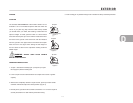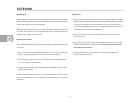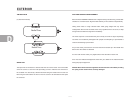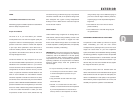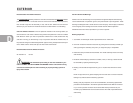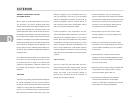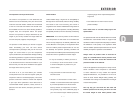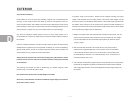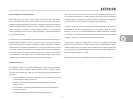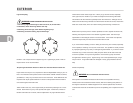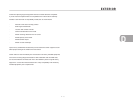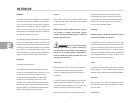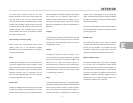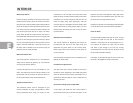
D
D - 11
EXTERIOR
The Importance of Proper Air Pressure
The amount of air pressure in a tire determines the
load that can be carried safely. Every tire will have the
maximum load and inflation molded into the sidewall
of the tire. This load and inflation ratio should never
be exceeded since this can cause handling problems,
irregular wear, and component failure. The proper
amount of air pressure is always determined by the
weight of your RV fully loaded. This weight takes into
account all liquids, supplies, and passengers.
Tire pressure is what enables your RV tire to support
loads. Overloading your tires can have serious
consequences for passengers and your RV. Too much
weight can cause stress on your RV’s suspension
system, brake failure, shock absorber damage, handling
and steering problems, irregular tire wear and possible
tire failure. Excessive loads or under inflation can lead
to an excessive amount of heat and tire failure. If you
discover that your tires cannot handle the load, lighten
the weight of the load on your tires.
The level of air in your tires affects your vehicle’s
overall performance. Not even the highest quality tire
will perform well if it’s not inflated properly. The correct
pressure varies from vehicle to vehicle and depends
in part upon driver preference. Each vehicle has a
recommended inflation pressure, usually found on a
placard on the door section, doorpost, glove door, or
fuel door.
Under Inflation
Under inflation brings a higher risk of susceptibility to
damage due to road hazards, reduces casing durability,
and causes a loss in fuel economy, plus uneven or
irregular tire wear. Severe underinflation brings about an
increased risk of tread separation, handling difficulties,
and possibly tire failure, which is caused by overheating.
IMPORTANT: It’s a common practice for RV owners to
lower tire pressure in their search for a smoother ride.
This is not only dangerous, it’s relatively ineffective, and
as the difference in ride quality is not significant. When
minimum inflation pressure requirements are not met,
tire durability and optimum operating conditions are
compromised. Tire inflation pressure should always meet
at least the minimum guidelines for vehicle weight.
• It may be necessary to inflate your tires at
a truck stop or truck service center in order
to achieve adequate air pressure for your
coach’s needs
• Only permanent air seal metal valve caps
should be used.
• Be safe - if a tire has been run 20% under
inflated, it must be dismounted and inspected
by a trained professional. It should not be
aired up without a full inspection or without
using a safety cage. Use a calibrated gauge. If
your tire is rated for higher inflation pressures,
a special gauge will be required designed for
larger tires.
• Don’t bleed air from warm tires to reduce
pressure buildup
Don’t inflate tires to cold PSI rating beyond rim
specifications.
Tire pressure should never be reduced below the vehicle
manufacturer’s recommended levels to support load
conditions in order to improve the ride quality of a vehicle.
The difference in ride quality is not significant. When
minimum inflation pressure requirements are not met, tire
durability and optimum operation can be affected.
Always check air pressure with an accurate air
gauge at a cold PSI. Never reduce pressure when
a tire is hot and never exceed the maximum cold
pressure molded on the sidewall.
Tires on RV applications are subject to a variety of more
severe conditions when compared to automobiles
or trucks. Because of many chassis and optional
equipment differences, it is possible for an RV to be
within its Gross Vehicle Weight Rating (GVWR), but
overloaded when taking into consideration the weight
of each wheel position.
The only way you can know the safe load and
inflation pressure for the tires your RV is to know
the actual weight of each wheel position under



